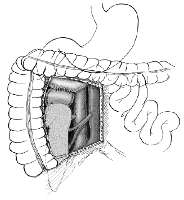Pancreas after kidney transplant in Saudi Arabia providing superior results to SPK simultaneous pancreas and kidney transplantation
Jens Brockmann1, Dieter C Broering1, Hassan AlEid2, Ahmed Zidan1, Ehab Abufarhaneh3, Tariq Ali2.
1Abdominal Transplant & Hepatobiliary Surgery, KFSH&RC, Riyadh, Saudi Arabia; 2Kidney and Pancreas Health Center, KFSH&RC, Riyadh, Saudi Arabia; 3Transplant Gastroenterology, KFSH&RC, Riyadh, Saudi Arabia
Introduction: PAK (pancraes after kidney transplantation) is criticized for higher risks of renal graft loss and higher mortality early after transplantation.
Methods: The pancreas transplant program at KFSH&RC, Saudi Arabia was restarted in December 2014.
All recipients of either SPK or PAK (n=76), including retransplants received exocrine drainage into the recipient duodenum and systemic portal drainage. Immunosuppression consisted of thymoglobulin induction & FK 506, MMF and steroid maintanence. Outcome comparison was made for PAK (n=25) and SPK (simultaneous pancreas and kidney transplantation; n=51) with a median follow-up of 4.2 years.

Results: Out of 76 pancreas transplants 25 were PAKs. Two rePAKs and one pancreas post SPK were included. 88 percent of recipeints had a living donor kidney transplant prior PAK. Median time from kidney transplant to PAK was 3.1 years. Pancreas donor risk index for PAK was 1.57 and 1.45 for SPK recipients. PAK recipients were 5 years older at time of pancreas transplant (34.5. vs 29.4 yoa). Duration of insulin dependency was significantly longer for PAK recipients (27.7 vs 21.3 years) whereas median time on dialysis was shorter (2.1 vs 2.9 years). Only one kidney allograft was lost in the PAK group after a run time of 22.4 years. Kidney allograft survival for PAK recipients was 96% versus 90% for SPK recipients. Despite an inferior pancreas allograft (PAK 60%. vs SPK 80%) recipient survival was clearly superior for PAK recipients (100% vs 80% for SPK recipients).
Conclusions: PAK in a country with a limited deceased donor organ donation rate (3-4 pmp) provides a valuable therapeutic option for patients suffering of type I DM with end stage renal disease. Despite an impaired deceased donor quality (high DRI for pancreas TX & high donor contamination rates) and basic medical care prior referral to an transplant center the overall outcomes are meeting international standards and are encouraging.
Discussion: The superior outcome for patient and renal allograft survival in the PAK group underline the importance of the renal allograft quality and a transplant center based follow-up.
[1] PAK
[2] SPK
[3] Duodenoduodenostomy
[4] protocol biopsy
